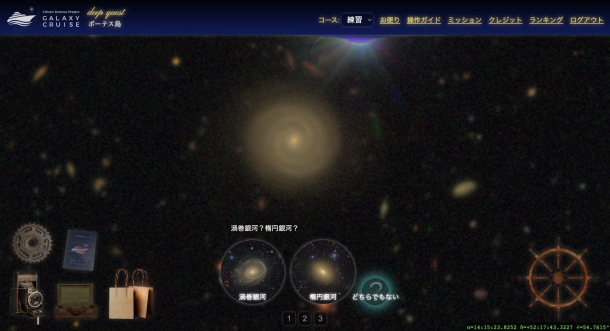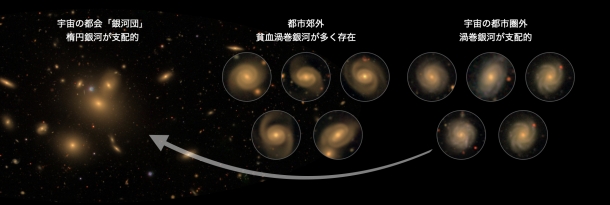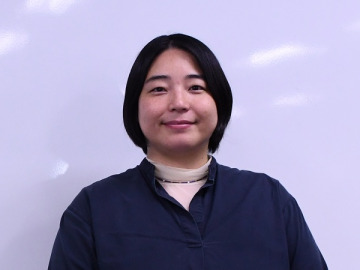
SHIMAKAWA Rhythm, Associate Professor
Classifying and analyzing galaxies in space to clarify their origin and formation
My research specializes in astronomy. I classify and analyze a vast amount of observation data gathered by using a large telescope in an attempt to comprehensively clarify when and where galaxies were born, and how they were formed. Galaxies are a collection of materials that include stars, planets, dust, and gases. For example, there are hundreds of billions of stars in the Milky Way Galaxy to which Earth belongs.
I am currently using image data in my research that have been captured by the Hyper Suprime-Cam (HSC) attached to the Subaru Telescope located near the summit of Maunakea on the Big Island of Hawaii. In addition to advanced light-condensing capability using a giant mirror measuring 8.2 m in diameter, the telescope has an extremely wide field of view and is capable of vividly capturing numerous celestial objects at once, down to their faint structures. Galaxies over 10 billion light years away can be observed, and thus far data on approximately 500 million celestial objects have been collected as of 2023. Artificial intelligence (AI) is essential to classifying this big data on galaxies, but AI requires an abundance of accurate samples to learn from.
As classifying faintly colored galaxies is difficult without the aid of the human eye, big data on galaxies is first classified by humans, and samples are created. These samples are used for AI learning to lead to a classification of galaxies using AI, but there is too much data for researchers to handle alone. Overseas, “Citizen Science” has become popular. Citizens use the internet to access astronomical data to cooperate with researchers and research institutes. This led to the National Astronomical Observatory of Japan (NAOJ) launching the GALAXY CRUISE project in 2019 to try to harness the power of Citizen Science. I also participate in this project as a research collaborator.
A Citizen Science Project: GALAXY CRUISE
GALAXY CRUISE is a project in which citizens, called Citizen Astronomers, classify galaxies captured by the Subaru Telescope. We researchers then analyze them as we try to solve the mystery of the formation and diversity of galaxies. There were 11,414 Citizen Astronomers participating from 102 countries and regions as of June 1, 2023.
When Citizen Astronomers access the GALAXY CRUISE webpage run by NAOJ, they will see expansive images of space taken by the Subaru Telescope. They can then click on the icon of the helm on the screen to be taken on a voyage through space and guided to a galaxy that has been automatically selected. Next, the Citizen Astronomers choose whether the galaxy that has appeared before them is a “spiral galaxy,” “elliptical galaxy,” or “neither” (Fig. 1). In addition to a central bulge in a sphere and disk, a galaxy in which a spiral structure is seen in the disk is classified as a spiral galaxy, while a thin disk with no spiral and a galaxy with only a sphere are classified as elliptical galaxies. Next, the Citizen Astronomers determine whether that galaxy interacts with other galaxies. The choices are “galaxies are interacting,” “galaxies are not interacting,” or “neither.” When “galaxies are interacting” is chosen, the Citizen Astronomers must further choose whether the characteristic shape is a “ring,” “fan,” “tail,” “or “distorted,” and finally click on the confirmation button. If they do not know or are unsure of the answer, they choose what seems to be the most likely choice.

Figure 1. The GALAXY CRUISE selection screen for classifying galaxies. Citizen Astronomers select the type of galaxy that appears in the center of the screen. After completion of the training program, Citizen Astronomers classify a sequence of actual galaxies. (Source: NOAJ)
There are many people participating in GALAXY CRUISE regardless of nationality or sex, but men comprise 70% with about 30% of them age 50 or older. Season 1 ended in April 2022, and Season 2 is now underway and includes even darker galaxies. In Season 1, Citizen Astronomers classified more than 20,000 galaxies in over two years. Since a single galaxy was classified by at least 50 people, we believe the results gathered are sufficient to ensure statistical analysis can be conducted. Of the classification results, answers chosen by approximately 70% or more Citizen Astronomers were learned by AI as the correct answer, and based on that AI successfully classified 1.4 million galaxies.
Finding where anemic spiral galaxies fit based on classification results from Citizen Astronomers and AI
Just like the population distribution on Earth, in space galaxies exist with a non-uniform distribution structure similar to multiple layers of bubbles. Interestingly, though spiral galaxies are typical and comprise over half of all galaxies, there are almost none in “celestial cities” (galaxy clusters) where many galaxies gather due to gravity. Do spiral galaxies somehow lose their spiral and become elliptical galaxies as they make their way to a celestial city? This question has long plagued galactic astronomy.
Therefore, out of the galaxies classified as spiral galaxies by Citizen Astronomers and AI, I have identified galaxies that are gradually losing their spiral and transforming into elliptical galaxies without a spiral, commonly known as anemic spiral galaxies, and succeeded in statistically ascertaining that these galaxies exist in an intermediate place in space similar to a new community found between the countryside and city (Fig. 2).

Figure 2. From the right, the figure shows spiral galaxies, anemic spiral galaxies, and elliptical galaxies in a galaxy cluster. I statistically ascertained that anemic spiral galaxies exist in an intermediate place similar to a new community between the countryside and city (Source: NOAJ, Rhythm Shimakawa)
Anemic spiral galaxies are celestial objects that are in the midst of losing their spiral as they make their way to the city. Perhaps the immediate factors that change the shape of galaxies may become clear if a more detailed analysis is conducted on anemic spiral galaxies.
(Reference: GALAXY CRUISE “What is an Anemic Spiral Galaxy?”)
Skillfully linking big data, Citizen Science, and AI to lead to analyses of galaxies
As explained above, we are promoting the national survey of space that teaches AI using results gained from Citizen Astronomers to classify numerous galaxies. Presently, the galaxies for which data have been analyzed represent a mere 3% of the night sky. The national survey is still in its early stage. With international cooperation, in several years there will be four telescopes dedicated to a large-scale survey and a major investigation of space will start full scale. It is anticipated that in ten years the amount of data will be more than a hundred times what it is now. Stated in the number of galaxies, that will be more than 20 billion galaxies. It is likely to be a golden age for big data in astronomy. As big data on galaxies progress going forward, I intend to make even greater efforts to skillfully utilize and leverage the power of Citizen Science and AI in analysis to solve the mystery of the origin and formation of galaxies.
Coverage/Constitution: AIMONO Keiko
Cooperation: Graduate School of Political Science, Waseda University, J-School










